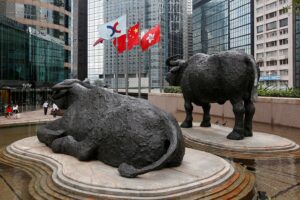Southbound funds, referring to mainland Chinese funds flowing into the Hong Kong capital market via the Stock Connect Scheme, continue pouring into Hong Kong stocks in April, with inflows exceeding 160 billion yuan, despite international capital outflows amid rising external uncertainties.
Year-to-date, southbound inflows have surpassed 600 billion yuan, and the market expects the full-year figure to break through the one trillion yuan mark.
Southbound Inflows Could Surpass 1 Trillion Yuan
After a brief correction in mid-April, Hong Kong stocks have rebounded as China reiterated support for exports and employment, the US adjusted some tariff policies, and mainland funds continued flowing south, with tech and consumer sectors particularly active.
Despite concerns over heightened uncertainties, net southbound buying has reached $78 billion so far this year—about 75% of 2024’s total inflow—and has become the primary source of capital for the Hong Kong market.
According to data from Wind Information, southbound investors have been buying AI technology stocks and high-dividend-yield stocks, contributing $29 billion and $22 billion, respectively — together accounting for around 65% of this year’s southbound inflows.
Southbound holdings of Hong Kong stocks have continued to rise, now reaching $577 billion, or 13% of the total market capitalization of eligible southbound targets, up from 10% a year ago, showed the data.
Goldman Sachs has raised its forecast for 2025 southbound inflows from $75 billion to $110 billion.
Zhao Wenli, Chief Hong Kong Equity Strategist at CCB International, noted that southbound capital this year is highly likely to exceed the 1 trillion yuan mark.
In the short term, the Hong Kong market still faces volatility risks stemming from external uncertainties, especially the threat of potential non-tariff sanctions, however, significant external shocks are likely to prompt China to roll out incremental policy support more quickly, said Zhao, expecting the Hang Seng Index’s 19,000-point level to serve as strong technical support.
Who’s Buying Hong Kong Stocks?
Currently, both domestic retail investors with account balances over RMB 500,000 and institutional investors can purchase eligible Hong Kong stocks and ETFs via the southbound channel.
Based on data from investment banks and disclosed holdings, institutional investors are estimated to account for at least half of southbound positions and are likely the main contributors to this year’s inflows.
For public funds in mainland China, under the current rules, if their names include the words “Hong Kong stocks,” over 80% of its non-cash assets must be invested in Hong Kong equities, while other funds are capped at a 50% allocation to Hong Kong stocks.
Based on data from funds that have disclosed asset allocations, roughly 20% of total AUM, Hong Kong-focused funds have allocated 84% of their assets to Hong Kong stocks, while other funds have a 28% allocation. The disclosed total Hong Kong holdings account for about 8% of all public fund assets.
Assuming all mainland public funds allocate roughly 20% of their assets to Hong Kong stocks, their total Hong Kong holdings could reach around $215 billion—about 35% of the total southbound holdings of $610 billion.
Also, assuming mainland hedge funds and private equity funds follow a similar 80/20 A-share/Hong Kong stock allocation ratio, their Hong Kong holdings could be around $70 billion—about 10% of total southbound holdings.
In addition, mainland pension and insurance funds manage roughly 6.5 trillion yuan in assets, with stock allocations of 10–15%. Assuming 20% of those equity investments are in Hong Kong stocks, their Hong Kong holdings could be around $20 billion, or 3% of total southbound holdings.
Tech as the Main Theme, New Consumption as the Subplot
By sector, southbound investors have maintained high exposure to the internet and financial sectors this year. By individual stock, Alibaba, Tencent, and China Mobile have seen the largest net southbound purchases, indicating that scarcity value and shareholder returns remain top priorities for investors.
The current bull run in the Hong Kong market is underpinned by a broad revaluation of Chinese tech assets, with new consumption emerging as the perfect secondary theme when the main tech storyline pauses. Mixue Bingcheng, Pop Mart, and Laopu Gold have become the three standout consumer stocks.
On March 5, Laopu Gold surpassed Tencent with a share price of HK$600, becoming the new “stock king” in the Hong Kong market, after surging more than 20-fold since listing in June last year. Other notable gainers include Mixue Group, which went public in Hong Kong in March and became the city’s new “frozen capital king,” with a current market cap exceeding HK$180 billion.

